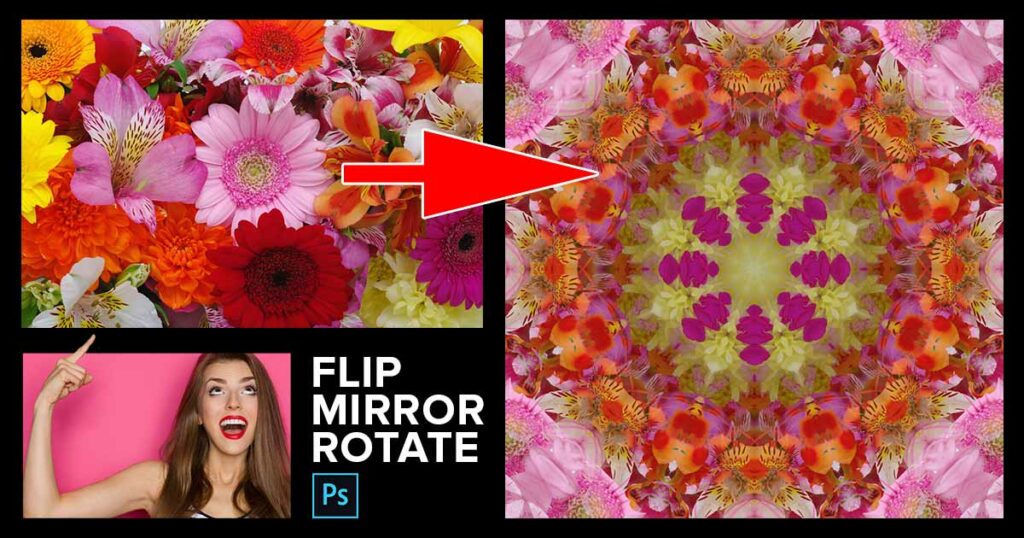A Symphony of Symmetry: Unveiling the Art of Flipping, Mirroring, and Rotating Image Designs and Patterns in Photoshop

Introduction:
Adobe Photoshop, a virtual playground for digital artists and designers, empowers creative minds to manipulate images with unparalleled versatility. Among the myriad tools at their disposal, the ability to flip, mirror, and rotate images stands out as a captivating technique that can transform ordinary designs into visually stunning masterpieces. In this exhaustive guide, we will embark on a comprehensive journey, exploring the nuances of flipping, mirroring, and rotating image designs and patterns in Photoshop, unlocking a world of artistic possibilities.
I. The Artistic Significance of Image Transformation:
1.1 Definition and Application:
- Flipping, mirroring, and rotating images involve altering their orientation, creating visually dynamic compositions.
- These techniques find applications in graphic design, digital art, photography, and various creative projects, offering a fresh perspective on familiar visuals.
1.2 Harnessing Symmetry for Impact:
- The symmetrical nature of these transformations often enhances the aesthetic appeal, creating balance, harmony, and a sense of intrigue.
- Artists can leverage these transformations to convey meaning, evoke emotions, or simply elevate the visual interest of their designs.
II. The Fundamentals of Flipping Images:
2.1 Horizontal and Vertical Flips:
- Photoshop allows users to execute both horizontal and vertical flips effortlessly.
- Horizontal flips mirror the image along its horizontal axis, while vertical flips do the same along the vertical axis.
2.2 Achieving Reflections:
- Horizontal flips can be particularly effective in creating reflective surfaces, mimicking the appearance of water reflections or mirrored elements in a composition.
- Experiment with different objects and scenes to explore the impact of flipping on reflection.
III. Mastering Mirroring Techniques:
3.1 Creating Mirrored Designs:
- Mirroring involves duplicating and flipping an image, producing a symmetrical result.
- Photoshop’s “Duplicate Layer” and “Flip Horizontal” commands are essential for achieving seamless mirrored designs.
3.2 Crafting Mandalas and Intricate Patterns:
- Mirroring is instrumental in crafting intricate patterns and mandalas.
- Utilize the “Rotate” and “Move” tools in conjunction with mirroring to create mesmerizing and balanced visual motifs.
IV. Unleashing the Power of Image Rotation:
4.1 Dynamic Rotations:
- Rotation introduces dynamism and movement to static images.
- Use the “Rotate” tool to turn images at various angles, enhancing the overall composition’s energy and direction.
4.2 Creating Surreal Perspectives:
- Rotating images allows artists to experiment with surreal perspectives, defying conventional expectations.
- Combine rotation with other transformations for visually arresting and thought-provoking results.
V. Advanced Techniques for Image Transformation:
5.1 Layer Transformations:
- Explore the transformative capabilities of Photoshop layers to apply intricate rotations, flips, and mirroring effects.
- Combine multiple layers with varying transformations for complex and layered compositions.
5.2 Perspective Transformations:
- Push the boundaries of reality by using perspective transformations to distort and reshape images.
- Create illusions and surreal effects by adjusting the vanishing points and angles.
VI. Crafting Seamless Compositions:
6.1 Aligning and Blending:
- Achieve seamless transitions between mirrored, flipped, and rotated elements by aligning and blending layers.
- Pay attention to details, ensuring a cohesive and polished final composition.
6.2 Layer Masks and Opacity:
- Utilize layer masks and opacity adjustments to blend transformed elements organically with the original image.
- Create ethereal and nuanced effects by selectively revealing or concealing portions of the transformed layers.
VII. Exporting and Saving the Final Composition:
7.1 Resolution and Quality:
- Consider the intended use of the final composition when choosing the resolution and file format.
- High-resolution images are crucial for print, while web projects may benefit from optimized file sizes.
7.2 Preserving Layers for Future Edits:
- Save the document in a format that preserves layers to retain the flexibility of making future edits.
- This is particularly important when experimenting with complex transformations and compositions.
VIII. Conclusion:
Flipping, mirroring, and rotating image designs and patterns in Photoshop is a transformative journey that empowers artists to reimagine reality and create captivating visual narratives. By mastering the fundamental techniques, exploring advanced transformations, and honing the art of crafting seamless compositions, designers can elevate their creative endeavors to new heights. Embrace experimentation, let your imagination soar, and allow the symphony of symmetry to guide you in crafting images that captivate, inspire, and leave a lasting impression.




